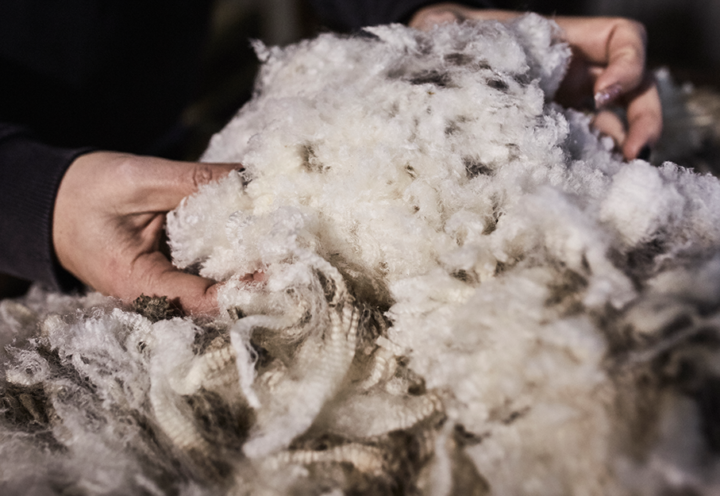We recently hosted a webinar with Stephanie Benedetto, Co-Founder of Queen of Raw, an NYC-based technology company with a marketplace solution that matches fashion organizations looking to offload excess fabrics with buyers interested in high quality sustainable and affordable textiles. Flora Davidson, Co-Founder of SupplyCompass sought to unpack with Stephanie her journey to date, the intricacies around deadstock fabrics, the economics of waste in fashion supply chains, and how technology has been integral to their revolutionary journey.
The conversation also focused on an important announcement — SupplyCompass’s exclusive partnership with Queen of Raw to bring a deadstock fabric offering to their client base through the SupplyCompass platform.
By joining forces, SupplyCompass Platform users will be able to access a myriad of deadstock fabric options via the SupplyCompass Deadstock Library to design more sustainable collections, create value from waste, and champion circularity. Highlighting the crisis of supply and unused inventory, the importance of seamlessly integrating these into a common platform and bringing all of it into the hands of the people who can use it was the main theme of the engaging conversation.
Stephanie explained her own family history, tracing the journey back to her immigrant grandfather finding and repurposing fabrics into haute couture fashion in the garment district in the Lower East Side of NYC in the early 20th Century. Prior to starting Queen of Raw, she had created a new leather alternative and while visiting mills, factories and warehouses, saw far too much fabric lying waste and headed for landfill. In 2014, she started to actively immerse herself into the issue and thus was born the idea to create technology to build the bridge between this supply-demand mismatch that would not only make sense for the planet, but also for economic profit.
Right off the bat, Stephanie was determined to bust myths around deadstock being scraps or second-hand goods, while in fact, deadstock is usually in the form of massive volumes, 100s of thousands of yards of the most beautiful, sealed in rolls in mint condition, ‘alive’ and ready to be used rather than ‘dead’. Flora corroborated this with her 2 years of working in India and visiting hundreds of factories to see rolls of fabrics destined for incineration or landfill. The fast pace of the industry prior to COVID-19 and how quickly items are churned out was considered central to the issue with Stephanie mentioning that waste is up to 15% of the bottom line of fashion businesses, making it at its core a financial issue that the industry should be worried about.

Stephanie also explained how the global platform and marketplace works, with the main website as an open platform for factories, brands, retailers and mills to sell fabric, including smaller scraps from the cutting room floor, 250 yards or under, to anyone from a student to big brands launching limited-edition collections. Targeted at small and medium-size business, the platform helps to democratize the system, removing the barrier of huge minimums. Along with this, Queen of Raw is also open to enterprise customers across the globe to buy deadstock, particularly valuable for them to leverage when their own supply chains are disrupted or they need a more sustainable story to tell. Flora mentioned the inherent democratization that deadstock could bring, drawing upon her experience with SMEs working with low MOQs and the collective purchasing models that have come into place as a consequence.
Overhauling old school ways, deadstock provided an easy, perfect way to start digitizing complex supply chains as the industry seeks to transform its redundant ways.
Stephanie also described how quick and easy it is to get started selling and buying deadstock, on the Queen of Raw website. The listings are all free and in addition, ample support is provided by the Queen of Raw team in a number of ways. Providing a holistic tech solution, the complexities of logistics are taken care of by them. Mapping and matching deadstock across the world, Machine Learning and Artificial Intelligence are employed to digitally connect the dots between people selling and the people who need it the most. To make it scalable for enterprise customers, the platform automatically identifies waste and automates the process to feed into the system, collecting the necessary sustainability data to enable these customers to reduce waste in their subsequent operations. Flora also mentioned that sustainability and efficiency go hand in hand, while also describing the increase in requests from SupplyCompass customers over the last few months, since using deadstock leads to shorter lead times, shaving off up to 6 weeks.
Examining the questions around sampling, Stephanie answered that the platform easily aids sampling by yardage, wherein the consumer can buy a yard, and if it isn’t what they need, turn it around and sell it on the same platform.
Discussing physical handling and quality control, Stephanie also clarified that the fabrics all sit in the original sellers’ warehouses and that the platform aims to find buyers close to the sellers, to cut down on shipping emissions, while the rest is offset and payment processing and logistics are fully automated. Quality Control is managed by carefully vetting and verifying buyers and sellers. Their partnerships with SAP and ERP systems integrate into the systems of their customers and bring in valuable information, including sustainability data, certifications, testing, where the fabric comes from and crucially, why it is classified as deadstock; for example made to a specific order, overbought and sitting in a warehouse for a certain amount of time.
Powerful storytelling is also part of the Queen of Raw vision as Stephanie described ongoing projects that would embed QR or RFID chips in products to let end consumers know that their purchase is Queen of Raw certified deadstock. Other technology discussed was the importance of 3D visualization and modelling, especially in the impossibility of attending physical fabric trade shows.

What are people willing to pay in the secondary market of deadstock? Stephanie replied that the textiles are entered at a discount that becomes steeper based on volume and urgency to get out into the hands of a buyer — up to 80% off wholesale price can be shaved off. This is still significant to a brand or retailer who would otherwise be spending money on warehousing, spending up to 1.40$ on warehousing for every 1$ of waste. Stephanie also mentioned that they spend a lot of time researching fair prices in the deadstock space, mentioning the opacity that exists with traditional jobbers or middlemen.
She also acknowledged that not everyone is going to be as digitally connected and tech-savvy as others. However, she reminded the audience that Queen of Raw did not make it necessary to be knowledgeable about technology or have ERP/inventory management systems and that they take both digital and physical files like .cvs’ and handwritten notes into the system. Additionally, before the pandemic, Queen of Raw also provided a physical team to factories to do the photography, uploading and verification of fabrics.
What are people willing to pay in the secondary market of deadstock? Stephanie replied that the textiles are entered at a discount that becomes steeper based on volume and urgency to get out into the hands of a buyer — up to 80% off wholesale price can be shaved off.
How does Queen of Raw measure and talk about impact in their work? Stephanie spoke about openness and willingness to talk about different crucial aspects, a common language to do so and impact analysis at the core of their work in the industry. Queen of Raw references the Higg index, as well as advice from MIT and the UN SDGs to map all the actions, calculate impact on the complex journey and give sellers a report to show what they achieved. As she mentioned, the planet is at a tipping point, and the focus needs to be on people, planet as well as business that has to be economically sustainable. Improving both the top and bottom line is important to Queen of Raw and hence was built an ROI calculator to assess how much money could be saved by buyers and sellers engaging with deadstock.
The webinar ended with musings about what the next 5 years could look like for the fashion industry. Flora mentioned that it was a challenging time for businesses now, but that she was excited about how digitization can be slowly introduced and scaled up, the visible shifts in mindsets about how technology can be game-changer, and how consumption patterns need to change. Stephanie emphasised on circular systems, peoples engagement with clothes, and more on-demand, local systems that will change the game, and that at the end of the day fashion has the power to help solve world problems when done right.



